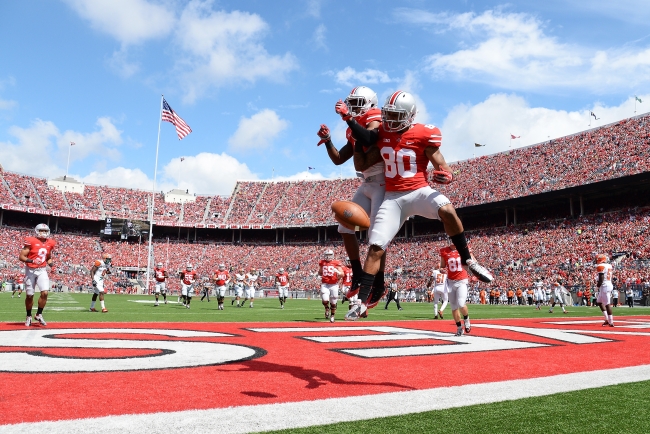You have /5 articles left.
Sign up for a free account or log in.

Ohio State players celebrate in the end zone, which they reached many times Saturday.
Getty Images
Ohio State’s football team was already up 69-0 over Florida A&M with just over two minutes left in the fourth quarter, but at the 10-yard line, there wasn’t much else they could do. So the quarterback Cardale Jones ran it up the middle for yet another touchdown (the Buckeyes got the point-after touchdown, too) for a final score of 76-0.
That was only one of the cringe-inducing games to transpire Saturday, during what was generally agreed to be the worst college football weekend of the season, competition-wise. Idaho State lost 56-0 against Washington. Two other universities -- Florida International and Savannah State – lost by 72 and 70 points to Louisville and the University of Miami, respectively. The latter game was apparently so ugly that the coaches agreed to shorten the fourth quarter from 15 to 12 minutes.
But in exchange for the team’s physical and emotional beating, Florida A&M received $900,000 (helpful for an athletic department facing a $6 million deficit), and valuable face time on national television (albeit under less than ideal circumstances). And by finding a willing victim, Ohio State got an easy win and a guaranteed step closer to a conference championship or national title.
“In most Division I sports, teams need to play (and ideally beat) a strong list of opponents to qualify for national championship tournaments, so coaches have an incentive to find quality teams for their out-of-conference schedules. In football, that isn't the case,” Welch Suggs, an associate journalism professor at the University of Georgia, said in an e-mail. “So which is the better value proposition: an easy home win (and the revenue that goes along with it) or a tough nonconference matchup that could spoil your chances in the polls?”
While the casual viewer might tsk-tsk at the coaches who condone 80-point routs of overmatched teams at the mercy of their cash-strapped athletics departments, the FAMUs of the world deserve a share of the blame, too, the Yahoo Sports columnist Dan Wetzel opined after that particular blowout.
“[Ohio State coach] Urban Meyer isn't the athletic director or president of Florida A&M, the people responsible for signing the Rattlers up for a game that they had no chance to win, were at an increased risk for injury and were almost assuredly going to suffer a monumental embarrassment,” Wetzel wrote. “Offering the deal is bad enough. Accepting it is worse though. It's not Ohio State's full-time job to look out for the physical and emotional health of the FAMU players. It's the school's administration.”
But Michael Smith, FAMU's athletics director, maintains that the experience for the team, as well as the recruiting opportunities the trip afforded, was “worth it.” FAMU has also played against the Universities of Florida and Oklahoma, Smith noted. He acknowledged the financial gain as well.
“[The games] do assist us in our overall operating budget…. But we’re not building our budget on the backs of our kids,” Smith said. “Our folks took the field with the mindset that they’re going to go out and block and tackle and get the best success and compete at the highest level they know how to compete at.”
Sometimes, officials may invoke a “mercy rule,” where a team is so hopelessly behind that to expedite the game, refs let the clock run first downs, out-of-bounds plays or other occasions where it would normally be stopped. In Louisville’s 72-0 slaughter of Florida International University on Saturday, the clock ran through in several instances where it wouldn’t normally have; it was originally thought to be at the request of coaches, but it was by accident, Conference USA officials said in a subsequent statement.
College sports are supposed to be part of a university’s mission – a well-rounded education, the argument goes, includes lessons in wellness, leadership and teamwork. But these games are a prime example of the other form that athletics takes, said Charles T. Clotfelter, a public policy and economics professor at Duke University: a commercial business.
“If this sort of thing went on in the playing field with our 14-year-olds, or our 7-year-olds, we’d think this isn’t really consistent with the kind of sportsmanship that we want to teach,” said Clotfelter, author of Big-Time Sports in American Universities (Cambridge University Press, 2011). “It seems kind of twice removed from what we ought to be doing in colleges.”
Not all colleges do it. The University of Notre Dame is one of at least two Bowl Championship Series teams (the most elite of the National Collegiate Athletic Association) that have never played a team in Division I’s less-competitive Football Championship Subdivision. Senior Associate Athletics Director John Heisler said in an e-mail that “Notre Dame has always taken pride in the strength of its football schedule.” (While No. 4 Ohio State was pounding FAMU into the ground Saturday, No. 22 Notre Dame was handing the respectable Michigan State Spartans their first loss of the season.)
And the Big Ten Conference discourages its members from playing FCS teams (though, as Ohio State demonstrated, the advice isn’t always heeded).
“Interest in those games is less. They're from another division. They have 20 less scholarships. It's like a junior college team playing against a high school team or a high school team playing against a JV team,” Big Ten Commissioner Jim Delany told reporters last month. “We're just trying to create a better package that was more interesting to the fan, more interesting to television, more interesting to the players that you can recruit to.”
And with a major shake-up coming to the football season format, the best teams in the nation might have more incentive to go that route. Currently, postseason bowl game berths are determined using a combination of polls and computer formulas. Strength of schedule is not a factor -- which, somewhat ironically, sometimes results in teams that pad their pre-season schedule getting treated to a blowout of their own in bowl games that the polls wrongly suggest they’re qualified for.
But with the College Football Playoff starting in the 2014 season, “cupcake opponents” will count against teams angling for a national championship in the eyes of the tournament’s selection committee, said James J. Duderstadt, president emeritus of the University of Michigan.
In the meantime, Duderstadt posited, a solution could be only allowing BCS teams to play other BCS teams -- “but the coaches would rebel.”
“It makes the season tougher,” he said in an e-mail, “and they are only one losing season away from the unemployment line.”
The Washington Post columnist John Feinstein proposed another course of action in his Sunday column condemning such games: only allow FCS teams that make their postseason tournament eligible for future games against FBS opponents, and limit them to one FBS game per tournament made. And make every FBS institution that agrees to the game ineligible for that season’s championship playoff.
“You can bet Ohio State won’t have Florida A&M on the schedule anytime soon if that happens,” Feinstein wrote.
But it’s good to keep things in perspective. Consider: In 1916, Georgia Tech beat Cumberland University 222-0.
“This is just chump change, this 77-0 stuff,” Clotfelter said.








